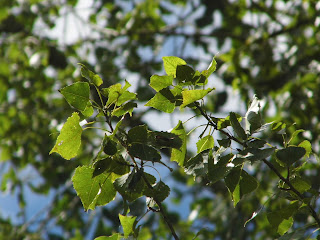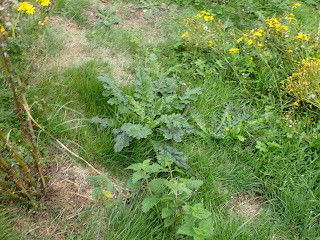Earlier in the summer I had been discussing butterflies with
Jim Bradley, and we agreed to head out for a day later in the summer. A late-summer species that neither of us had seen before was Brown Hairstreak, so we decided to head to
Chambers Farm Wood in Lincolnshire to seek out this species. Inicdentally several small populations have been seen in recent years a bit closer to Norfolk in the Ipswich area, but the Suffolk butterfly recorder believes these to be unauthorised introductions.
Upon heading into the woods we hadn't gone very far before we noticed hiarstreaks flying high up around pathside trees. Several were definitely Purple Hairstreak, and we were to see 10+ of this species, including two on the ground. Typically the more interesting hairstreaks were more mobile and we couldn't conclusively ID them.
This finally changed when we arrived at an area known locally as the Minton triangle, which sounds a bit like it should be a Quality Street chocolate. We had an orangey-brown butterfly flying high along the trees in an area where a couple of friendly butterfliers from Newark had just been watching a Brown Hairstreak. It took a while, but eventually it reappeared, and we managed to get bins views of the Brown Hairstreak flying over some Blackthorn.
The next part of the day involved a lot of standing around looking at vegetation in areas where other people had seen one a few minutes ago. We went back to the car for lunch, during which time one had apparently been perched up for nearly an hour. Despite our flight views we both had really hoped for at least one stationary view. We had gleaned a few useful nuggets of information from our fellow lepidopterists, notably that 11:30-2:30 was the best time for non-flight sightings, Angelica was the best plant to watch, and the area with the most sightings recently wasn't where several butterfliers saw them in previous years.
We began a slow walk back, and having gone past the triangle I suddenly spotted a female Brown Hairstreak nectaring on some Angelica. It stayed put for a few photos, before flying up onto a tree overhanging the path. Here it opened its wings, albeit we could hardly see it from the angle we were at. Jim then found a male a bit further down the path, which stayed put for even less time. Brief encounters, but great to get good views of my final one of the five British Hairstreaks.
Thanks to Jim for doing the driving, and to the many friendly people we met on site who gave advice and tried to help us see the butterfly.
























































